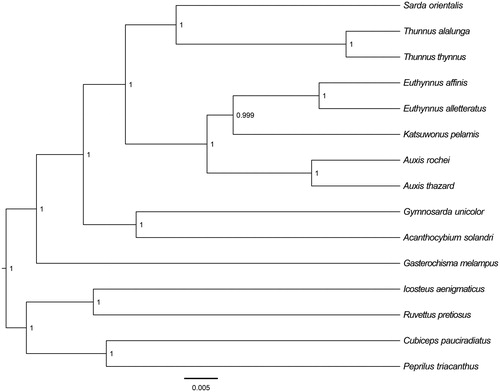Abstract
Auxis rochei is one of genus Auxis and widely distributed in tropical and subtropical waters. In this study, we described the complete mitochondrial genome of A. rochei. The genome is 16505 bp in length, encoding the standard set of 13 protein-coding genes, 21 transfer RNA genes, two ribosomal RNA genes, and a non-coding D-loop, with circular organization. The overall base composition of the whole mitochondrial genome was A (27.92%), T (25.01%), G (17.09%), and C (29.98%) with an AT bias of 52.94%. The longest protein-coding genes of these species was ND5, whereas the shortest ATP8.
The genus Auxis are cosmopolitan species and the smallest members of the tribe Thunnini. It is currently recognized the existence of two distinct species, the narrow-corseleted Auxis thazard and the wide-corseleted Auxis rochei (Collette and Aadland Citation1996). Morphologically, they are differentiated primarily by the width of the corselet under the origin of the second dorsal fin and by the anterior extent of the dorsal scaleless area above the pectoral fin. The bullet tuna A. rochei is a commercially important scombrid. It is the smallest among all tuna species with a maximum fork length of about 50 cm (Collette et al. Citation2001).
Here, we sequenced and annotate mitogenome of A. rochei form South China Sea to provide molecular information for genetically understanding of bullet tuna.
The specimens of A. rochei were collected from the South China Sea (21°30′N, 118°30′E) in 17th September, 2017. Whole genomic DNA was extracted from muscle tissue of one specimen of A. rochei using TIANamp Marine Animals DNA Kit (TIANGEN, China). The concentration for use as a PCR template was adjusted to an A260 of about 0.05 to 0.2. The collected specimen and extracted DNA were stored in Guangdong Provincial Key Laboratory of Fishery Ecology and Environment. The complete mitochondrial genomes of A. rochei was sequenced using PCR primers designed from highly conserved regions of transfer RNA (tRNA) sequences of related species (Catanese et al. Citation2008) with additional specific primers designed as required from sequences already obtained. Long-PCR amplifications were performed by thermo-cycling using five pairs of primers and PCR amplicons were subjected to build up genomic library and pair-end sequencing by MiSeq. The COI sequence of A. rochei was used as reference seeds for iterative assembly by MITObim v.1.8 (Hahn et al. Citation2013). SeqMan v.7.1.0 was used for the mitogenome assembly and annotation (Swindell and Plasterer Citation1997). Transfer RNA genes were predicted using online software tRNAScan-SE 1.21 (Lowe and Eddy Citation1997). All Protein coding gene (PCGs) are aligned independently, then concatenated to be applied for phylogenetic reconstruction with other Scombriformes in MrBayes v 3.12 (Ronquist and Huelsenbeck Citation2003) using relaxed clock model.
The A. rochei mitochondrial genome forms a 16505 bp closed loop (GenBank accession number MK548578). The overall base composition of the whole mitochondrial genome was A (27.92%), T (25.01%), G (17.09%), and C (29.98%) with an AT bias of 52.94%. This mitochondrial genome represents a typical Auxis mitochondrial genome and matches with the A. thazard genome (Catanese et al. Citation2008), in which it comprises 13 protein-coding genes, 21 transfer RNA genes, and two ribosomal RNA genes (12S rRNA and 16S rRNA) and one A + T-rich region which could also be termed as control region. The ATG initiation codon are used in all protein-coding genes except COX1 (GTG), ND1 (ATA), ND3 (ATT), and the stop codons of all the 13 protein-coding genes were complete. Meanwhile, the longest protein-coding genes of these species was ND5 (1812 bp), whereas the shortest ATP8 (165 bp). lrRNA and srRNA genes are 1692 bp and 948 bp in length separately, and the length of D-loop is 557 bp. All the 21 typical tRNAs possess a complete clover leaf secondary structure, ranging from 68 bp to 74 bp. The Bayesian inference phylogenetic tree showed that A. rochei firstly grouped with species of A. thazard (). We have the confidence to construct phylogenetic trees, based on the complete the mitochondrial genomes, but the evolution history of cutlassfish still needs future research to be clearly resolved.
Figure 1. The Bayesian inference phylogenetic tree for Scombriformes based on mitochondrial PCGs and rRNAs concatenated dataset. The gene’s accession numbers for tree construction are listed as follows: Auxis thazard (KP259551), Katsuwonus pelamis (AB101290), Euthynnus alletteratus (AB099716), Euthynnus affinis (KM651783), Thunnus alalunga (KP259549), Thunnus thynnus (AB097669), Sarda orientalis (AP012949), Acanthocybium solandri (AP012945), Gymnosarda unicolor (AP012510), Gasterochisma melampus (JN086156), Cubiceps pauciradiatus (AP006038), Icosteus aenigmaticus (AP006026), Ruvettus pretiosus (AP012506), and Peprilus triacanthus (AP012518).

Disclosure statement
None of the co-authors has any conflict of interest to declare. The authors alone are responsible for the content and writing of the paper.
Additional information
Funding
References
- Catanese G, Infante C, Manchado M. 2008. Complete mitochondrial DNA sequences of the frigate tuna Auxis thazard and the bullet tuna Auxis rochei. DNA Seq. 19:159–166.
- Collette BB, Aadland CR. 1996. Revision of the frigate tunas (Scombridae, Auxis), with descriptions of two new subspecies from the eastern Pacific. Fish Bull. 94:423–441.
- Collette BB, Reeb C, Block B. 2001. Systematics of the tunas and mackerels (Scombridae). Fish Physiol. 19:1–33.
- Hahn C, Bachmann L, Chevreux B. 2013. Reconstructing mitochondrial genomes directly from genomic next-generation sequencing reads-a baiting and iterative mapping approach. Nucleic Acids Res. 41:e129.
- Lowe TM, Eddy SR. 1997. tRNAscan-SE: a program for improved detection of transfer RNA genes in genomic sequence. Nucleic Acids Res. 25:955–964.
- Ronquist F, Huelsenbeck JP. 2003. MrBayes 3: Bayesian phylogenetic inference under mixed models. Bioinformatics. 19:1572–1574.
- Swindell SR, Plasterer TN. 1997. Seqman, contig assembly. In: Swindell SR, editor. Sequence data analysis guidebook. Totowa (NJ): Springer; p. 75–89.
